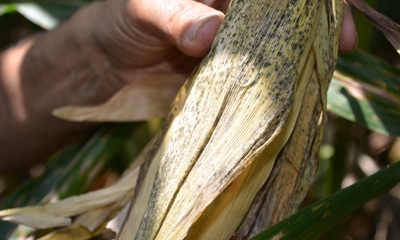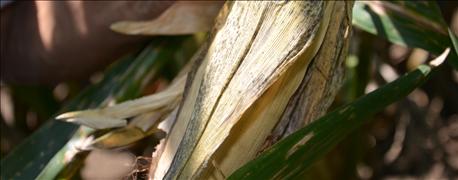
For most of Indiana, the 2016 growing season will go down as warmer than normal and wetter than normal. Nearly everyone saw the warmer-than-normal trend. Some areas saw more rain than others, but most areas received at least enough rain to keep crops growing when they needed moisture most.
The Crop Watch ’16 field was in the warmer-than-normal, wetter-than-normal area. Dave Nanda wasn’t surprised to find these three corn diseases in the field: gray leaf spot, southern rust and diplodia ear rot. All three prefer warm, humid weather.

SOME LIKE IT WARM, WET: Diseases that prefer warm, damp conditions with high humidity at key times flourished in corn this year.
What was surprising and helpful to yield was that the diseases came in late during the growing season, says Nanda, a plant breeder and crops consultant for Seed Consultants Inc., sponsor of Crop Watch ’16. It’s likely they developed late enough that there will be little, if any, effect on yield.
Here is a closer look at the three diseases. Information describing these diseases can be found in the 2016 Purdue University Corn and Soybean Field Guide.
.jpg?width=300&auto=webp&quality=80&disable=upscale)
Gray leaf spot lesions (below left) start small and become up to 2 inches long. They are rectangular and pale-brown, tan or gray. Symptoms can appear on lower leaves in early July.
In the Crop Watch field, lower leaves were still virtually clean at pollination. The disease came in afterward. When it came in, during a very warm, humid spell, it came in quickly.
Gray leaf spot is more of a concern when it reaches the ear leaf or above, Nanda says. By the time that happened this year, corn in the Crop Watch field was at brown silk and grain fill was progressing. There was likely little impact on yield. Gray leaf spot overwinters in corn residue.

Southern rust has light-brown to orange pustules (right) that make it hard to miss. Nanda found it in the Crop Watch field in the second half of August, but only on a few leaves.
Agronomists in southern Indiana claim that by mid-September, if you walked a field, you often came out with "orangeish" clothes. An orange-colored haze during combining occurred in some of the most heavily infected fields.
Southern rust doesn’t overwinter in Indiana; it blows in from the South. It arrived relatively late in most areas this year. Yield damage was likely minimal. The Purdue guide notes that southern rust stays mostly on upper leaf surfaces. You will find common rust on both upper and lower surfaces.

Diplodia ear rot (left) is in a group of ear molds that like warm, humid weather at silking and in the two to three weeks following silking. Conditions were ideal for this disease in some areas, Nanda notes. Hybrids vary in resistance to this disease.
Diplodia produces a white-to-gray mold that begins at the base and moves up the ear. It doesn’t produce toxins.
The diplodia ear rot photo is courtesy of Charles Woloshuk, Purdue University plant pathologist.
About the Author(s)
You May Also Like




